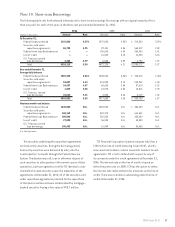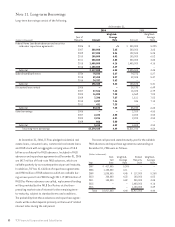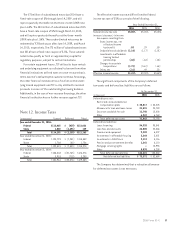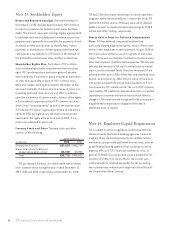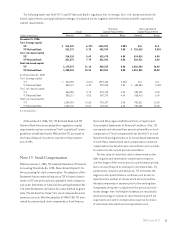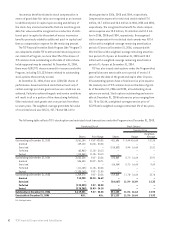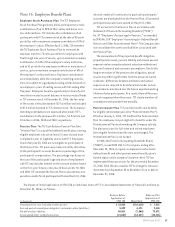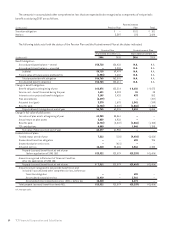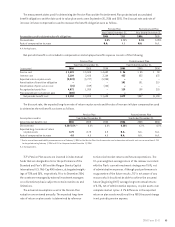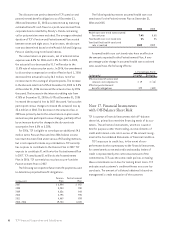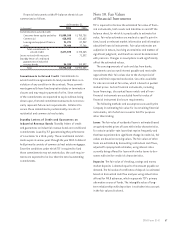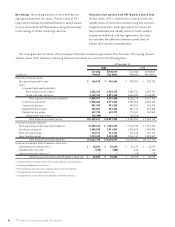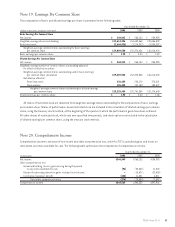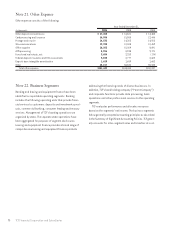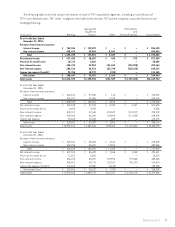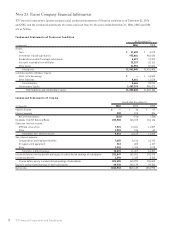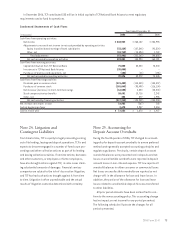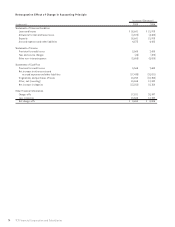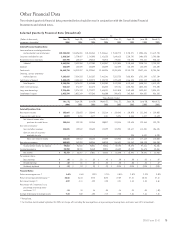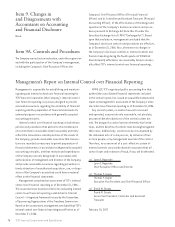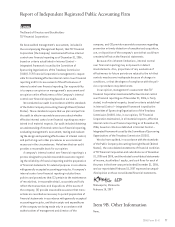TCF Bank 2006 Annual Report Download - page 87
Download and view the complete annual report
Please find page 87 of the 2006 TCF Bank annual report below. You can navigate through the pages in the report by either clicking on the pages listed below, or by using the keyword search tool below to find specific information within the annual report.
2006 Form10-K 67
Financial instruments with off-balance sheet risk are
summarized as follows.
At December 31,
(In thousands) 2006 2005
Commitments to extend credit:
Consumer home equity and other $1,889,100 $1,750,738
Commercial 618,055 811,652
Leasing and equipment finance 91,271 87,909
Other 79,444 77,766
Total commitments to
extend credit 2,677,870 2,728,065
Loans serviced with recourse –71,332
Standby letters of credit and
guarantees on industrial
revenue bonds 96,285 100,892
Total $2,774,155 $2,900,289
Commitments to Extend Credit Commitments to
extend credit are agreements to lend provided there is no
violation of any condition in the contract. These commit-
ments generally have fixed expiration dates or termination
clauses and may require payment of a fee. Since certain
of the commitments are expected to expire without being
drawn upon, the total commitment amounts do not neces-
sarily represent future cash requirements. Collateral to
secure these commitments predominantly consists of
residential and commercial real estate.
Standby Letters of Credit and Guarantees on
Industrial Revenue Bonds Standby letters of credit
and guarantees on industrial revenue bonds are conditional
commitments issued by TCF guaranteeing the performance
of a customer to a third-party. These conditional commit-
ments expire in various years through the year 2018. Collateral
held primarily consists of commercial real estate mortgages.
Since the conditions under which TCF is required to fund
these commitments may not materialize, the cash require-
ments are expected to be less than the total outstanding
commitments.
Note 18. Fair Values
of Financial Instruments
TCF is required to disclose the estimated fair value of finan-
cial instruments, both assets and liabilities on and off the
balance sheet, for which it is practicable to estimate fair
value. Fair value estimates are made at a specific point in
time, based on relevant market information and information
about the financial instruments. Fair value estimates are
subjective in nature, involving uncertainties and matters of
significant judgment, and therefore cannot be determined
with precision. Changes in assumptions could significantly
affect the estimated values.
The carrying amounts of cash and due from banks,
investments and accrued interest payable and receivable
approximate their fair values due to the short period of
time until their expected realization. Securities available
for sale are carried at fair value, which is based on quoted
market prices. Certain financial instruments, including
lease financings, discounted lease rentals and all non-
financial instruments are excluded from fair value of
financial instrument disclosure requirements.
The following methods and assumptions are used by the
Company in estimating fair value for its remaining financial
instruments, all of which are issued or held for purposes
other than trading.
Loans The fair value of residential loans is estimated based
on quoted market prices of loans with similar characteristics.
For certain variable-rate loans that reprice frequently and
that have experienced no significant change in credit risk, fair
values are based on carrying values. The fair values of other
loans are estimated by discounting contractual cash flows,
adjusted for prepayment estimates, using interest rates
currently being offered for loans with similar terms to bor-
rowers with similar credit risk characteristics.
Deposits The fair value of checking, savings and money
market deposits is deemed equal to the amount payable on
demand. The fair value of certificates of deposit is estimated
based on discounted cash flow analyses using actual rates
offered for FHLB advances, which represents TCF’s primary
alternative source of funds. The intangible value of long-
term relationships with depositors is not taken into account
in the fair values disclosed.


